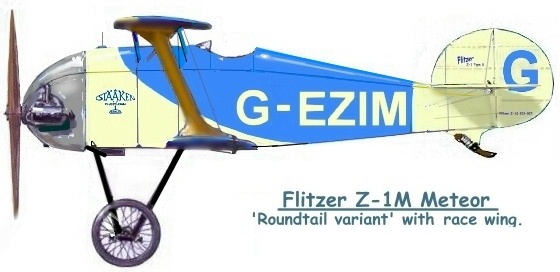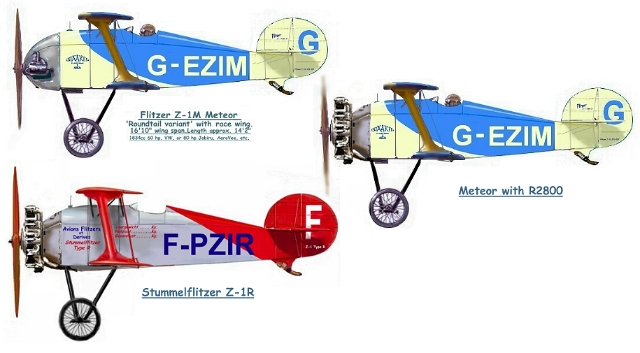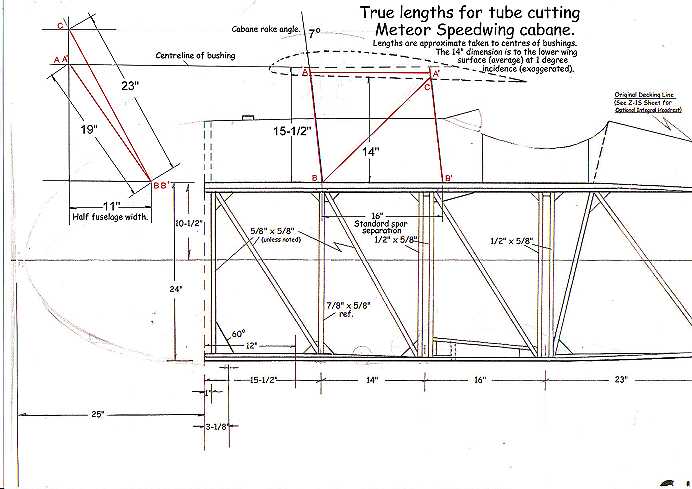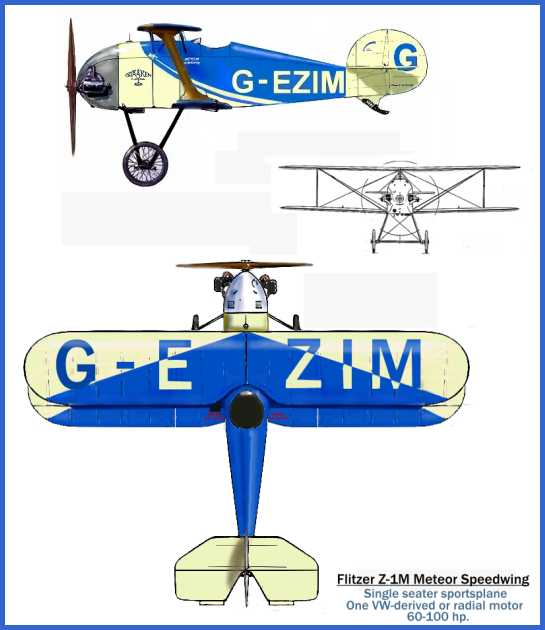


September 23, 2005
Hi Group,
I liked the Stummel scheme of blue/cream so much that I did for Emmanuel's Z-1S, that I then tried it on the Goblin, but it ddn't work so well... something to do with the balance of block colour that only a fixed fin and a certain fuselage proportion will provide. So I re-hashed the old Fitzer Meteor racer and added the Stummel fin and rudder. Here is the result which I think works quite well.
Any comments?
LynnSeptember 25, 2005
Hi Group,
The attachment is a pencil sketch only, but is a more accurate impression of the Flitzer Z-1M than was sent previously.
Many components of this aeroplane exist, although it was originally intended to fit a Type 1 fin and rudder - with a lowered profile. The Stummel-type fin can be built onto the adapted Z-1M fin to create the sleek machine that is shown here. Other changes from the prototype Z-1 are the raked cabane, and rounded wing tips, like the Stummels, although the tailplane planform remains the same as the prototype Z-1, but with the 25% deepened (Z-21) profile.
The raked cabane allows a bigger tank bay within a shortened fuselage without compromising stagger. Overall length is similar to the Z-1 S Roundtail, but the span is about a foot less. Fuselage is fabric -covered aft of the seat, like the Goblin and Z-2.
It has 100% commonality with Flitzer Z-21 metal parts, Gary!
Regards,
Lynn
September 25, 2005
Group,
After Blake's posting of the Rotec on Ebay, I got to wondering how the Meteor might look with the R2800 installed.
Lynn
September 26, 2005
Group,
Further to the discussion on the arch-radius on the Z-21, etc., here for interest, is the firewall frame for the Meteor.
The fuselage width is a compromise 23", ie. exactly between the Z-21 and 21A, so thicker flying apparrel is an option if going for the height record!
The primary fuselage depth is 24", same as the Z-21, whereas on the first evolution, which became the Z-1S Stummelflitzer, I adopted a reduction in fuselage depth to 22.5" to make it easier to work on the aeroplane over the upper longeron 'sill'. The decking height was then increased on the Stummels to make the eyeline the same as on the Z-21. On the Meteor, the firewall arch is 8.5" in height (it's 7" on the Z-21) so the option is to raise the secondary frames to 9" to create the beginning of the nose line-curvature, as on the Z-21, or to maintain the entire forward decking section at 8.5" throughout, to create a straight line, parallel to the longerons. This would allow a whole range of cowling options, including a facsimile 'rotary' cowl, which would make the aeroplane look a lot like a Nieuport 28 in the air.
Best regards,
Lynn
Hi Hartmuth,
Well the Z-1M (Meteor) was what took over in the form of the reductive minimum Flitzer type (after the Stummelflitzer grew up with four ailerons, increased chords, deeper spars, etc.), and was being built by a friend of mine, who abruptly abandoned it about five or six years ago. The Goblin then became my final replacement of the minimalist Flitzer type, and was perhaps the most radical in several ways.
However, taking stock of both the Goblin and Meteor 'kits', I find I now have substantially more bits to complete the Meteor than the Goblin, although I am almost equally fond of both. The colour scheme I evolved for Emmanuel's Stummelflitzer in Normandy, so appeals to me, in its bright, defined Art Deco style, that I tried on the Goblin - but it didn't really work.
It works really well on the Meteor though, something to do with the balance of the colour blocks, especially if I re-build the fin and make a new rudder, to mimic the Stummel or Z-21 Roundtail look.
The Race Wing, is merely a term I coined for the shortened Z-21 wing, with the thickness-chord ratio reduced from 12% (USA 35B) to 10% or 9%, from the interplane struts to the new, rounded tips, which will reduce induced drag on the smaller span wing, and will also reduce roll-damping (still using just two ailerons for simplicity). It will look a lot like a Stummelflitzer, except for the rectangular Type 1 tailplane. I'm tempted to make a part-swept LE, lightened Stummel-type tailplane, but then I'd be reducing the advantage of using pre-existing Meteor components. However, the extant tailplane is fairly heavy, so I may yet do just that. In effect, it will look just like a shorter-chord wing Stummelflitzer, with a fabric-covered rear fuselage. It will have reduced dihedral compared to the Z-21, and will have a bigger tank bay, aided by the raked cabane. Span will be either 17', or 17'6" on the upper wing, with a slight span differential, like the Stummel Type S.
The advantages are that is will be a very light machine and if fitted with a light, powerful motor, it will perform better than a heavier, more powerful example, especially with regards to climb.
I can't wait to get to grips with it again.
Best wishes,
KesslerNovember 27, 2007
Group,
Here is a quick (reduced) diagram to show the cutting lengths of the Z-1M cabane tubing. I will send the full file size to Chris and any other Meteor Speedwing builder who wants one.
Jim, if you re not already on the FSV Group, note that Chris Bobka is providing tubing kits at very, very reduced prices, but these can only be supplied en masse, together with Z-21 & 21A kits, so if you want to order a complete tubing kit for the Z-1M now's the time. The prices will not be matched anywhere on the planet. The shorter raked cabane of the Z-1M is the only noticeably different element in these two basic models.
Chris, I will confirm the undercarriage tube lengths of the Z-1M, but as far as I know there'll be no difference.
Cheers,
Lynn
January 15, 2008
Group,
Here's a preview of the new Z-1M Meteor Speedwing fuselage drawing. Apologies for the contrast problems, but it's only offered as a general impression to a small file size.
Lynn
February 14, 2008
Group,
Here's a three-view drawing of the Flitzer Meteor Speedwing for general interest. A GA is a prerequisite to establish any design for the issuing authority in order to formulate the paperwork and to arrange permit inspections.
Lynn